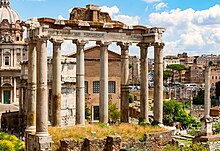Temple of Saturn
The Temple of Saturn is located in the Roman Forum in Rome and was built at the foot of the Capitol . Its (allegedly) originally between 501 and 498 BC The building erected in BC is considered to be the second oldest temple in ancient Rome.
history
The original building is said to have been built in the early days of the Roman Republic , but supposedly went back to a project by Tullus Hostilius or Tarquinius Superbus . However, this early dating, which can only be traced back to much later literary sources, cannot be archaeologically confirmed. According to various sources, the temple was consecrated either by: 1. Titus Larcius during his dictatorship in 501 or his second consulate in 498; 2. Aulus Sempronius , consul of the year 497; 3. Postumus Cominius , the consul of the years 501 and 493, on the basis of a senate resolution. However, since the literary sources of the early Roman period are very unreliable, many researchers today doubt that the temple was actually built that early.
In the 4th century BC The temple was renewed by a Lucius Furius, possibly as a result of the invasion of the Gauls ; It is more likely, however, that the first building was only erected around this time. In the decade before last Then a complete rebuilding of the temple was carried out on behalf of Lucius Munatius Plancus , who financed this with his spoils of war. Eventually the temple burned down again towards the end of the 3rd century and was restored in 283. The temple front with its pillars and the inscription on the preserved architrave dates from this period :
- SENATVS POPVLVSQVE ROMANVS INCENDIO CONSVMPTVM RESTITVIT
- Destroyed by fire and rebuilt by the Senate and the Roman people.
Even before the temple was built, the site had an altar dedicated to Saturnus . The anniversary of the temple's consecration was one of the highest Roman holidays and was celebrated around December 17th in a multi-day festival, Saturnalia .
location
Seen from today's route across the forum, the temple is located directly behind the Rostra , the ancient orator's plateau on the forum, near the Arch of Septimius Severus . In Roman times the Via Sacra ended directly in front of the temple. The Clivus Capitolinus led around the temple to the Capitol .
meaning
In addition to its religious significance for ancient Rome, the temple also played an important secular role in the Roman Republic: the aerarium populi Romani was located in the porch of the temple, i.e. the repository of the Roman state treasure , which was therefore also called aerarium Saturni . The tables of the law and Senate resolutions were also kept here. The threshold of the entrance to the aerarium has been preserved to this day, although the actual porch has almost completely collapsed. On the east side of the podium you can still see holes from plaques on which the Acta diurna , the public notices, were posted.
construction
The remains of the temple visible today come from various construction phases. The columns of the preserved front made of gray and pink granite go back to the restoration of the year 283, like the associated four-sided Ionic capitals made of white marble. In contrast, the architrave and frieze belong to a building from the late 2nd or early 3rd century and were reused at the Temple of Saturn, as the preserved decorations on the inside of the blocks facing the pronaos show. The front was trimmed to accommodate the above-mentioned inscription. Additional smaller blocks of the entablature, which also differ stylistically from the others, were used above some of the pillars. They compensated for the larger front width, for which the entablature was not originally designed. The Geison finally is again used herein to build the Munatius Plancus to connect and was. The travertine- clad podium made of opus caementicium rose above the remains of the previous building in early August, and the aerarium was probably located under the frontal staircase.
literature
- Samuel Ball Platner , Thomas Ashby : A Topographical Dictionary of Ancient Rome . Oxford University Press, London 1929, pp. 463-465 ( online ).
- Filippo Coarelli: Saturnus, aedes . In: EM Steinby (Ed.): Lexicon Topographicum Urbis Romae IV . Rome 1999, pp. 234-236.
- Patrizio Pensabene: Il Tempio di Saturno. Architetture e Decorazione . Rome 1984.
- Lawrence Richardson Jr .: The Approach to the Temple of Saturn in Rome . American Journal of Archeology 84, 1980, pp. 51-62.
Web links
- The Temple of Saturn on Roma Antiqua
- Digital Roman Forum of UCLA, Saturnus, aedes
- Reconstruction and information on the Temple of Saturn on the website of the 'digital forum romanum' of the Humboldt University in Berlin
Individual evidence
- ↑ Macrobius 1,8,1; Dionysius of Halicarnassus 6,1,4.
- ↑ Macrobius 1,8,1, which here follows Varro.
- ↑ a b Dionysius of Halicarnassus 6,1,4.
- ↑ Livius 2,21,1 and Dionysius of Halicarnassus 6,1,4.
- ^ Suetonius, Augustus 29; CIL 6, 1316 ; CIL 10, 6087 .
Coordinates: 41 ° 53 ′ 32.7 " N , 12 ° 29 ′ 2.8" E




